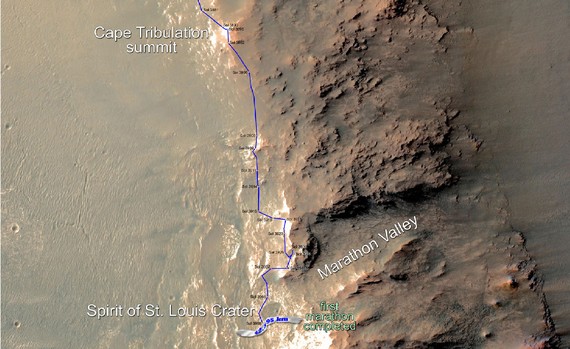NASA’s Opportunity Rover Completes a Martian Marathon

A self-portrait that was taken by the NASA rover Opportunity weeks before its tenth landing anniversary on Mars. NASA/AP
The Mars probe is the first human-made vehicle to travel 26.2 miles on a non-Earth planet.
Only 11 years and two months after it began, NASA’s Mars Opportunity rover has completed a marathon across the planet’s barren red desert. The rover made its final roll toward the 26.219-mile mark Tuesday morning, logging in a total of 26.221 miles (42.195 kilometers) on its odometer.
“It’s historic,” said John Callas, a NASA astronomer who manages the Mars Exploration Rover project, in an interview. “This is the first time any human enterprise has exceeded a marathon somewhere other than Earth.”
Opportunity was designed to drive a distance of only one kilometer. Its current record is 42 times longer than that. “It’s like having a car that’s supposed to last 100,000 miles, and then you drive it 4 million miles without ever changing its oil—that’s just amazing!” Callas said. For the past few months he and his colleagues have been counting down the distance on an office whiteboard. The final leg of the race, about 140 feet, is an entry they now feel lucky to erase.
“We’re well past our warranty on this rover,” said Callas. “The thing we live with every day is that the rover can die tomorrow.”
And there are many things that can go wrong with a robot that’s past its prime. For instance, the team thought the wheels would wear out, a problem that helped decommission Spirit, its twin rover, two years and seven kilometers into its mission. Even Opportunity’s final push did not come without its hurdles. Days before the golf-cart-sized vehicle began the last part of this journey, Callas and his team had to reformat its flash memory, a portion of which was becoming corrupted and causing episodes of “ amnesia .” For three months Opportunity operated without its flash memory, which normally stores crucial operating data that the rover can utilize whenever it’s powered up. The fix included recreating part of the rover’s software, a task Callas likened to reprogramming your computer’s operating system while it’s 140 million miles away.
Now with its memory reformatted, Opportunity is prepped to investigate Marathon Valley, which was named in honor of the distance the rover travelled to get to it. The dusty destination is located on the western rim of Mars’s Endeavor Crater, and is of special interest to NASA because the organization’s orbiting spacecraft has hinted that there might be clay minerals in the valley. Clay minerals form in locations with neutral pH levels, like water. A key finding here may offer clues to the idea that the Red Planet was friendlier to microbial life when it was a warmer and wetter place.

Investigations like this are part of the reason why it took Opportunity 11 years to complete a marathon. The rover’s mission is to explore. Every day on Mars, it drove up to interesting geological features and spent time inspecting them, in much the same way that a geologist kneels down to examine a rock with a brush and magnifying glass. The rover has been busy every day of those 11 years, and while the Soviet Union’s Lunokhod 2 moon rover traveled 24.2 miles (39 kilometers) in only five months, it stopped a mere three kilometers shy of being the first to make the historic milestone. But on July 27, 2014, Opportunity overtook Lunokhod 2’s record for longest distance travelled by a vehicle outside of Earth, and then went on to cross the metaphoric marathon tape.
“Our rover only moves about as fast as a tortoise, so the analogy of the tortoise and the hare—slow and steady wins the race—is the case here,” Callas said of the record-setting trek. “Our tortoise—this rover—did win the race.”
Though Opportunity may have bested the rovers that came before it, Callas contends that there’s no competition between it and its younger, more agile cousin Curiosity. Rather, Callas said the objective for both of these vehicles is to do the best job they can for advancing scientific exploration. Still, he said he celebrates the historic side-achievements. “The marathon has become significant in the human experience,” Callas said. “Now that distance has been replicated on another world.”
NEXT STORY: Industry Sells Congress on Internet of Things





